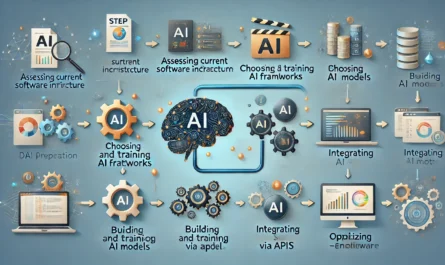In today’s rapidly evolving marketplace, the ability to adapt quickly and efficiently is a cornerstone of business success. Business agility refers to an organization’s capability to swiftly respond to external and internal changes without losing momentum or vision. Flexibility is at the heart of this agility—enabling businesses to adjust strategies, operations, and mindsets to meet new challenges head-on. But how can businesses truly enhance their agility? The key lies in adopting flexible strategies that enable organizations to respond to disruptions, capitalize on opportunities, and thrive in an uncertain world.
Businesses must remain adaptable, constantly evolving their approaches to meet changing demands. Without flexibility, even the most established companies can fall behind.
Why Businesses Need Agility
The global business landscape is in a constant state of flux. Companies are no longer competing within static markets. Instead, they are navigating dynamic environments where technological advances, consumer behavior shifts, and economic uncertainties constantly reshape the playing field. Agility, as a business trait, is about maintaining the ability to pivot when necessary while keeping long-term objectives intact.
Whether you’re a startup or a multinational corporation, agility allows you to turn challenges into opportunities. It enables faster decision-making, improves customer experiences, and boosts operational efficiency. As technology accelerates changes in industries across the board, agility is more essential than ever before. Inflexibility can lead to stagnation, but businesses that embrace change and adaptability will find themselves positioned for sustainable success.
The Core of Business Agility
At its core, business agility involves a mindset and a set of practices that empower companies to innovate, respond to disruptions, and seize emerging opportunities quickly. The foundation of business agility includes:
- Leadership that fosters innovation and change: Agile businesses rely on leaders who embrace change and encourage their teams to do the same. Leaders who set the tone for flexibility and openness to new ideas create an environment where agility can thrive.
- Collaboration across departments: Cross-functional teams enhance business agility by bringing different perspectives to the table, which fosters innovation and rapid problem-solving.
- Customer-centricity: Businesses that are focused on listening to and understanding their customers can adapt more effectively to changing market needs.
Flexible Strategies for Business Agility
Flexible strategies are pivotal to achieving agility. Flexibility allows companies to pivot their business models, modify their product offerings, and even shift their organizational structure without compromising their core mission. But implementing flexible strategies isn’t about random change; it’s about making informed decisions that enable businesses to better meet objectives while staying responsive to market conditions.
- Scenario Planning: Agile businesses engage in scenario planning, preparing for multiple potential futures. This practice allows businesses to react quickly to unexpected events.
- Modular Business Models: Implementing modular business models, where individual business units or products can operate independently, offers a way to experiment and innovate without disrupting the entire organization.
Embracing Change to Drive Agility
Change is inevitable, and embracing it is key to enhancing business agility. Agile companies welcome changes, viewing them as opportunities for growth rather than threats. This mindset requires fostering a culture that prioritizes adaptability, experimentation, and learning from failures.
- Fostering a Learning Organization: Businesses that prioritize continuous learning and development are better positioned to adapt to changes.
- Responsive Product Development: Agility in product development means listening closely to customer feedback and using it to drive iterations and improvements in real-time.
The Impact of Technology on Business Agility
Technology is a driving force behind many changes in today’s business environment, and leveraging it effectively can significantly boost business agility. Digital transformation initiatives, such as implementing cloud solutions, automation tools, and data analytics platforms, allow businesses to respond quickly to market shifts and customer demands.
- Cloud Solutions for Flexibility: Cloud computing allows businesses to scale their operations up or down as needed, which enhances their flexibility and agility.
- Automation and Agility: Automation tools can help streamline repetitive processes, freeing up time for teams to focus on innovation and strategic decision-making.
Implementing Flexible Decision-Making
Flexible decision-making is essential for businesses aiming to stay agile. In an agile organization, decisions aren’t confined to the top echelons of leadership. Instead, decision-making authority is often delegated to teams, allowing them to respond rapidly to emerging challenges or opportunities.
- Decentralized Decision-Making: Agile companies often practice decentralized decision-making, empowering employees at all levels to make decisions that support the organization’s goals.
- Rapid Prototyping and Testing: Agile businesses use rapid prototyping and testing methodologies, allowing them to quickly adapt their strategies based on real-time feedback.
Resilience and Agility
Resilience is closely linked to agility. An agile organization not only reacts swiftly to changes but also has the resilience to withstand and recover from disruptions. Building resilience involves creating systems and processes that are robust yet flexible enough to adapt when necessary.
- Building a Resilient Workforce: Investing in employee well-being and development is critical to building resilience, as engaged, well-prepared teams are better equipped to handle change.
- Resilient Supply Chains: Ensuring flexibility within the supply chain is another crucial aspect of building a resilient, agile business.
Customer-Centric Flexibility
Customers’ needs are continually evolving, and businesses that remain customer-centric can enhance their agility by adapting to these shifts. Building flexibility into your customer engagement strategies means being responsive to feedback, adjusting products or services, and communicating effectively with your target audience.
- Feedback Loops: Creating efficient feedback loops allows businesses to gather insights from customers quickly and adjust their strategies accordingly.
Data-Driven Flexibility
Data is a powerful tool for businesses looking to enhance their agility. Organizations that use data analytics to inform their decisions can pivot more effectively, as they are guided by real-time insights rather than assumptions.
- Predictive Analytics: Predictive analytics enables businesses to anticipate changes in the market or customer behavior, giving them a head start in adapting their strategies.
- Data-Driven Decision-Making: Data-driven businesses make more informed, flexible decisions that align with their agility goals.
Measuring Business Agility
Measuring business agility requires the use of specific metrics to assess how quickly and effectively a company can respond to changes. Common metrics include time to market, innovation rate, and customer satisfaction scores.
- Agility Metrics: Agility metrics track how effectively a company is adapting to change, measuring factors such as speed of decision-making and the time taken to roll out new initiatives.
You can also read; How to Create a Crisis Management Strategy for Your Business
Strategies for Continuous Improvement
Agility isn’t a one-time goal; it’s a continuous process. To remain agile, businesses need to constantly refine their strategies, processes, and products in response to feedback and market shifts.
- Kaizen and Continuous Improvement: The concept of Kaizen, or continuous improvement, is central to many agile businesses. By fostering a culture of ongoing refinement, companies can stay ahead of competitors and consistently improve their operations.
Continue enhancing your business agility by refining leadership practices, embracing cross-department collaboration, and using customer insights to fuel innovation. With flexible strategies, your business can stay adaptable and future-proof in an ever-changing landscape.



